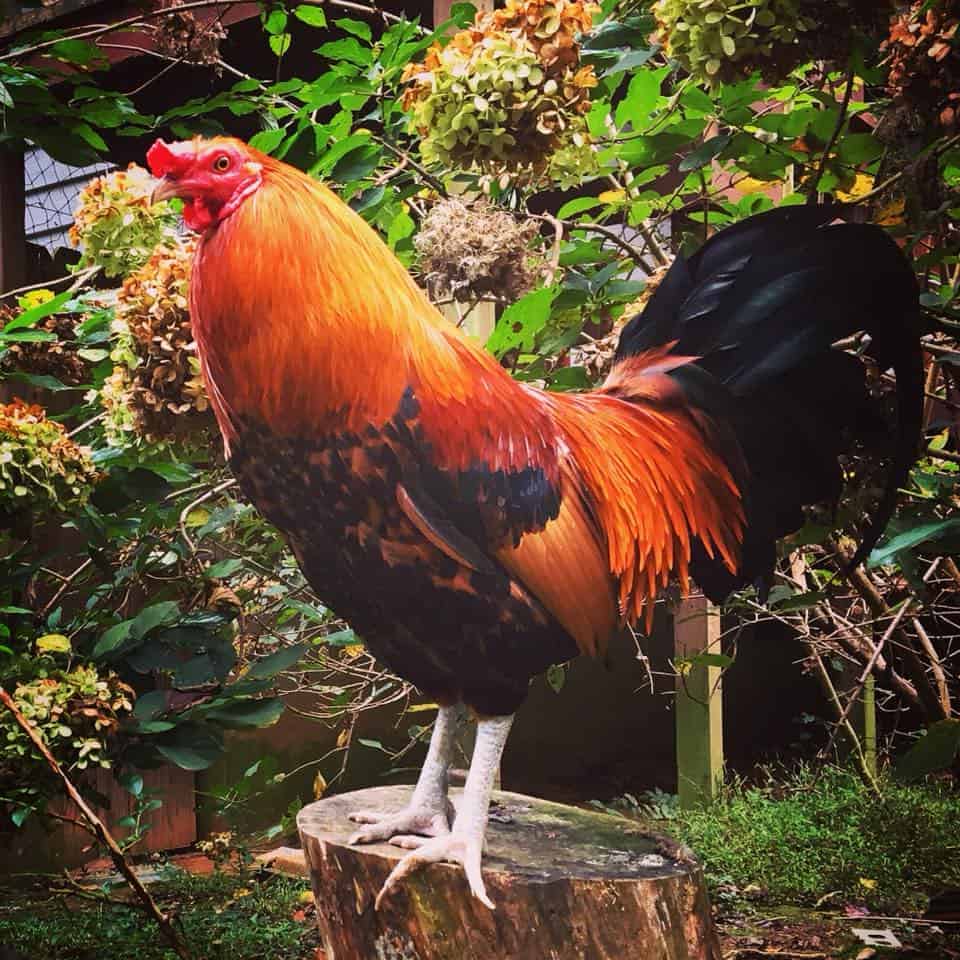
Updated June 30, 2021
Highly Pathogenic Avian Influenza
For compassionate caregivers of avian residents, highly pathogenic avian influenza (“HPAI”) has presented a dual pronged threat. HPAI is both a serious health threat to birds and with regards to associated legal control measures. We strongly urge that sanctuaries caring for avian residents stay informed about HPAI risks both in their region and more broadly so that they can take appropriate measures to keep their residents protected. This includes implementing a biosecurity checklist as well as associated measures, such as cleaning and access logs to avian residents. Heightened quarantineThe policy or space in which an individual is separately housed away from others as a preventative measure to protect other residents from potentially contagious health conditions, such as in the case of new residents or residents who may have been exposed to certain diseases. measures are also highly suggested while the threat of HPAI persists.
Like most animals, chickens are happiest when they have lots of space to roam and explore and have an indoor space that protects them from the elements. While predators can be a concern for mammalian residents, chickens and other bird species are especially vulnerable, so it is important to keep predator-proofing in mind when designing both indoor and outdoor spaces.
Keep It Safe!
If you are bringing new chickens into your life, you also need to ensure that you have an appropriate quarantine space to keep you and your existing residents safe!
Indoor Living Spaces For Chickens
A barn, shed, or garage can make a suitable indoor living spaceThe indoor or outdoor area where an animal resident lives, eats, and rests. for chickens so long as certain guidelines are followed. Whether you are building something from scratch or turning a prefab or pre-existing structure into a chicken living space, you’ll need to take certain steps to ensure the space is appropriate for your residents. There are many factors to consider when determining how much space chickens need; there is no magic number we have to offer. Not all residents are going to do well with the general recommendations offered online or even those offered by established sanctuaries, so you’ll need to be prepared to increase their living space if that’s what they need.
A few sanctuaries offer guidelines for the bare minimum amount of space needed, but keep in mind these are minimums and may not reflect the amount of space they strive to provide for their residents.
Chicken Run Rescue– Their Recommendations for Municipal Regulations for Urban Chickens (which is in the process of being revised) states “4 sq. feet of floor space minimum is required per bird for the interior…. Temperament and social structures should be taken into account, and partitions should be available for birds who are sick, injured or lower in the pecking order.”
Farm Sanctuary– Their 2018 Farm AnimalA domesticated animal that is used by humans either for their body or what comes from their body. Farmed animals have fewer regulations governing their welfare than other species in many countries. Care Conference resources state, “Chickens who are overcrowded, just like in an industrial setting, are more inclined to fight and spread disease quickly. Chickens need a minimum of 5 square foot [sic] per bird for living space, but, of course, more is better.” Their resource for large breedDomesticated animal breeds that have been selectively bred by humans to grow as large as possible, as quickly as possible, to the detriment of their health. chicken care recommends a minimum of 8-10 square feet per large breed chicken.
United Poultry Concerns– In Providing a Good Home For Chickens, it states, “The purpose of a coop is to provide shelter from direct snow, ice, rain, direct wind, and predators. It should be roomy (at least 8 to 10 square feet per bird), well-insulated, and well-ventilated.”
Use these as a starting point, but be aware that there are many factors to consider when determining the amount of space needed to keep your residents comfortable and happy. Age, breed, sex, health issues, activity level, flock dynamics, climate, and type of outdoor space should be considered when creating a space or determining a space’s capacity.
Predator-Proofing
Chickens are very vulnerable to predation, especially overnight. Because of this, chickens must be closed into their indoor space before dusk and should not be let out again until the sun is coming up in the morning. Therefore, chickens require an indoor living space that will keep them protected from all predators while they are closed in overnight. A good rule of thumb is to avoid any openings that are the size of a quarter or larger. Weasels, for example, can squeeze through spaces as small as a quarter and can kill an entire barn of chickens. Raccoons, while unable to fit their entire body through small spaces, can reach their arm through small openings and grab and kill a chicken. This means you cannot have gaps around or under doors, and any openings in the roof, such as a vent in the peak or in the soffit, must be covered. We suggest all openings that are the size of a quarter or larger are covered with ¼- ½” galvanized hardware cloth, as this should prevent predators from entering the chickens’ enclosure. Raccoons have been known to open simple latches, so you should employ additional methods of protection such as bungee cords, a double bolt snap, or install a 3-step locking system, especially if raccoons or similar predators are a concern in your area. Open windows should also be covered in galvanized hardware cloth; a regular window screen is not enough to keep predators out.
Beware of Hardware Disease
When using galvanized hardware cloth, it’s safest to cut pieces in an area away from chickens because ingesting pieces of galvanized metal can lead to heavy metal toxicity in birds.
Wooden structures can develop breeches overtime through warping, rotting, or from predators chewing their way into the space. In addition to checking for breeches regularly, we highly recommend that all wooden structures have additional layers of protection. A wooden floor can be reinforced with sheet metal, and walls can be reinforced with galvanized hardware cloth.
In addition to the typical predators that may come to mind like hawks or foxes, you also need to protect the chickens in your care from rats. Rats can kill chickens or cause injury by chewing on them as they sleep. Rats will likely be one of the biggest risks to your chicken residents, so be sure to take necessary precautions to deter them, such as keeping food in tightly sealed covered metal bins and cleaning up any spilled food. If the structure is insulated, it must be done in a way that prevents rodents from gaining access to the insulation, because rodents will make themselves a cozy home inside your insulated walls if they can! One way to do this is to sandwich sheet insulation with a layer of ¼-½” galvanized hardware cloth on either side to keep rodents from chewing it. This means an insulated wall may consist of the following layers- plywood (or whatever material you want as the visible interior wall), galvanized hardware cloth, sheet insulation, another layer of galvanized hardware cloth, and then the exterior wall. If you opt against using this method or something similar, you will need to watch for breeches in the wall that allow rodents to get to the insulation. Never simply place exposed insulation against your wall or roof. To read more about predator proofing, check out our detailed resource here!
Check out this lovely visual starter guide on chicken predator-proofing topics from our friends at P.E.A.C.E. Canada!
Flooring
When choosing the type of flooring that is best for your residents, keep in mind that large breed chickens, as well as bigger breeds of chickens and birds with mobility issues will need more traction than a healthy smaller breed chicken. You can find more information on large breed chicken care needs here.
Traction MUST Be Considered If Housing Large Breed Chickens
Because of their size and propensity for foot and joint issues, it is imperative that large breed chickens have a flooring and bedding combination that provides good traction, at all times and in all conditions, as even a minor slip could result in serious injury.
Who Are We Talking About When We Say “Large Breed Chickens?”
We use the term “large breed” to refer to Cornish crosses and other chickens who have been bred to grow quickly – not as quickly as Cornish crosses, but quicker than other breeds – and are typically marketed as “free-range broilers.” As a group, they are often called “colored hybrid broilers” but include many different Trade names such as Freedom Ranger, Red Ranger, and Kosher King. Though other breeds of chickens, such as Orpingtons and Jersey Giants, are sometimes raised for their flesh, they do not face the same inherent challenges as Cornish crosses and chickens who fall into the category of “free-range broilers,” and are not who we are referring to when we say “large breed.”
Concrete, wood, and dirt are common types of flooring used in chicken living spaces. Concrete provides good protection from predators without the need for additional layers of protection; however, it must be slightly textured in order to provide adequate traction. Concrete that is too rough may cause damage to foot pads, but smooth concrete will be too slippery. A concrete floor, even with a thick layer of bedding, may be too hard on a chicken’s joints, especially large breed chickens, but the addition of rubber stall mats can help provide additional cushion. Be aware that stall mats must provide good traction, even when wet. It’s also important to keep in mind that stall mats can be cumbersome to move and can make living space cleaning more arduous. Wooden flooring, which comes with many prefabricated sheds, does not provide good traction, especially when wet, so for large breed chickens, you’ll likely need to add stall mats. Wooden floors will warp and rot, leading to more maintenance over time. Dirt flooring, while the easiest on the feet and joints, will not protect against predators, especially those who dig, and therefore must be used in conjunction with other predator-proofing methods. A thick layer of dirt can be packed on top of a concrete floor or over galvanized hardware cloth, or it can be combined with concrete trenching, which should prevent digging predators from entering the structure. Dirt flooring is difficult to clean and disinfect and must be added to as it erodes.
Regardless of the type of flooring used, chickens will also need ample amounts of dry bedding. Straw and wood shavings are common types. The use of straw carries an increased risk of aspergillosis, so may not be appropriate depending on other environmental factors and your residents’ overall health. If you opt for wood shavings, look for “low dust” or “dust extracted” types. Aspen and pine wood shavings are popular options, and while we’ve talked to many sanctuaries that use pine shavings with no issues, be aware that there is conflicting research regarding whether or not pine shavings are entirely safe to use around birds. Cedar wood shavings should never be used because it can cause severe respiratory issues.
Large Breed Chicken Bedding Challenges
In some instances, large breed chickens will obsessively eat their bedding. This tends to be more common with younger large breed chickens, and they often grow out of the behavior, but it can lead to serious cropA crop is a pouched enlargement of the esophagus of many birds that serves as a receptacle for food and for its preliminary maceration. issues (which can have fatal consequences if left untreated), so you must make modifications until the behavior subsides. If you find that large breed chickens in your care are eating their bedding, swap out the straw or wood shavings for sheets or non-woven blankets for a period of time. This behavior is usually temporary, but be sure to watch closely when they are reintroduced to straw or wood shavings to ensure that they are no longer eating their bedding.
Perching And Nesting Opportunities
Instinctively, chickens want to perch up off the ground to sleep because this is what their wild cousins do to help protect themselves from predators. Because perching is a natural behavior for them, it is important you offer ample perching options for your residents. Many chickens will do just fine with a store-bought perch or even a properly secured, sturdy branch. Make sure that any perches you offer are sturdy and are made of materials that will not cause injury to a chicken’s foot. Be sure to offer enough perching spaces for everyone to safely fit and for those who may want to avoid certain members of the flock to be able to do so. Keep in mind that not all chickens will be able to fly up to a high perch- multi-tiered perches work well for larger flocks and allow chickens to hop from lower perches up to higher ones. They also utilize vertical space well, thus taking up less floor space.
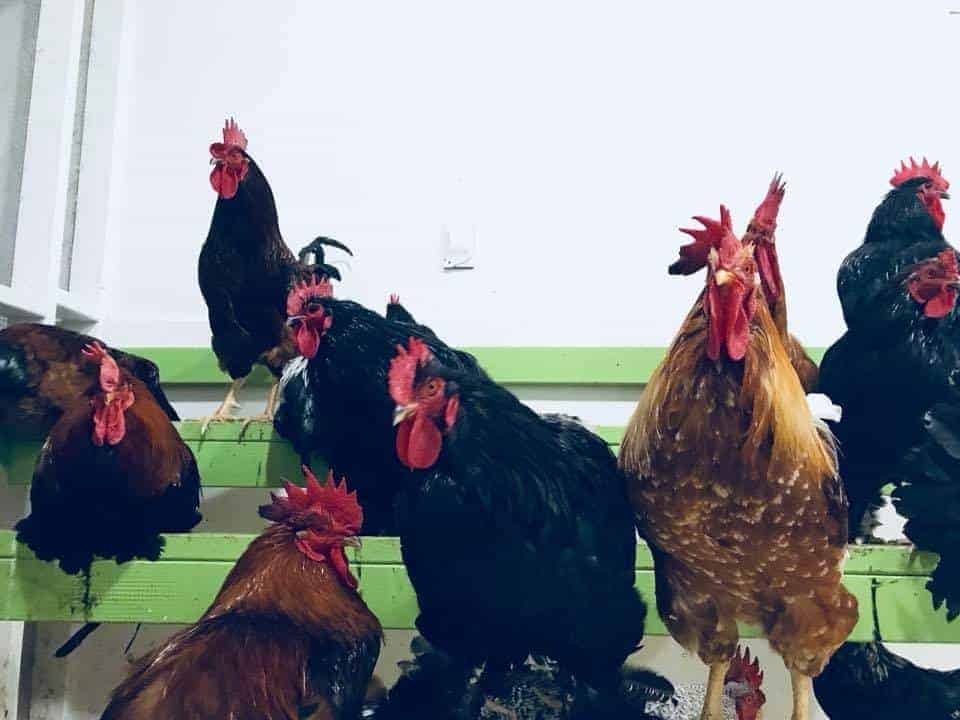
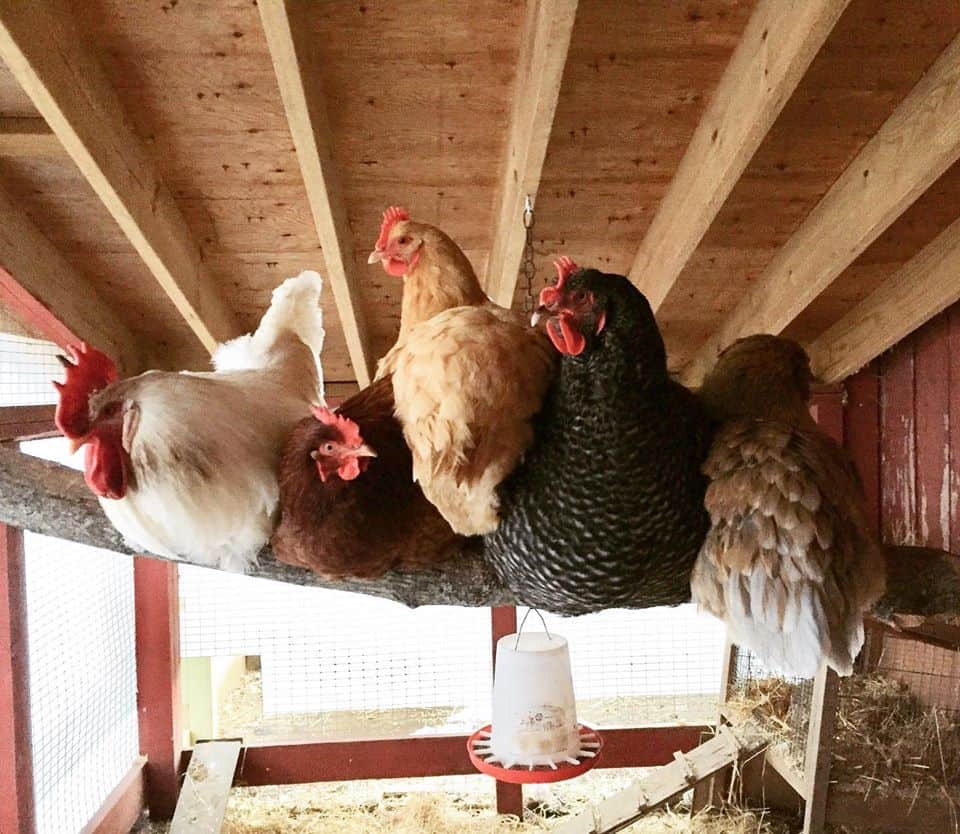
Large breed chickens, as well as some bigger breeds or those with mobility issues, may not be able to use a rod-style perch, but will still need a way to sleep up off the ground. A simple solution is to provide small straw bales as roosts. It is best to use straw baled with twine rather than wire, as the wire can potentially cause injuries. Be sure to provide enough space for everyone to comfortably spend the night up on a bale. The most important things to remember are that whatever you provide must be sturdy, and there should be no gaps between bales or between individual bales and the wall where a chicken could get their leg caught. Cover the tops of the bales with loose bedding for easy clean-up.
Actively laying hens need nesting areas- cozy nooks where they will feel safe laying and sitting on an egg. You can find nest boxes online or at your local feed store. You want enough nest boxes so that hens do not have to fight over space, but generally one nesting area per every 2-4 hens is a good starting point. Make sure nesting areas are free of any hazards that could cause injury and that they cannot be tipped over. Keep nest boxes filled with an ample amount of fresh bedding- this will keep hens comfy and help prevent eggs from breaking.
Large breed hens may not be able to safely use nest boxes designed for other breeds of chickens. An easy way to provide nesting areas to large breed chickens is to arrange three straw bales to create a ground-level nook. Place two bales against the wall with about a two foot gap between them. Then put the remaining bale on top so that it creates a roof over the opening and overlaps with each bale. Ensure there is enough overlap that the bale is secure. Create enough of these spaces so that hens are not fighting over nesting areas. A few hens will likely be able to share one nesting area. Fill the nesting nook with plenty of fresh bedding, and cover the tops with a layer of bedding as well. These nesting areas are multifunctional- they work as perch bales too!
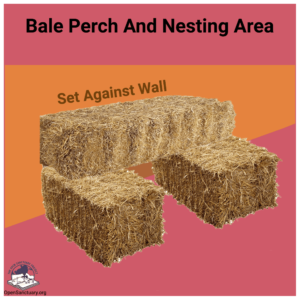
Summer Considerations
While different individuals will have different thresholds for how much heat they can handle, it’s important to note that chickens are more vulnerable to heat related issues in temperatures above 80 degrees Fahrenheit and that large breed chickens tend to be more sensitive to extreme temperatures than other chickens. Chicken living spaces need ample ventilation to prevent health issues and also need to be maintained at a comfortable temperature. Industrial circulating fans and built-in exhaust fans can do a good job keeping the space well ventilated and cool, and keeping windows open (as long as they are covered with galvanized hardware cloth) can also help. If you use an exhaust fan, make sure it does not create openings for predators to enter when the fan is not in use. In areas where nighttime temperatures remain warm, the use of a predator-proof screen door (rather than a solid door) can help keep a space comfortable overnight while also providing protection.
Winter Considerations
Some chickens will be more sensitive to the cold than others, so it will be important to pay close attention to residents to determine what temperatures keep them comfortable. In addition to ensuring their comfort, it’s important to protect them from dangerous temperatures and weather conditions. Chickens are much more likely to develop frostbite in temperatures under 20 degrees Fahrenheit. In colder periods, it’s important to keep living spaces draft-free while still allowing for ample ventilation- spaces that become too humid can cause significant respiratory illnesses.
Condensation Concerns
If you feel condensation on the walls or ceiling of a barn in the wintertime, it must be immediately ventilated as it is far too moist for safe chicken habitation!
Having windows that are above chicken height or using exhaust fans can help allow airflow while still keeping the chickens out of a direct draft. If temperatures are safe enough to allow your residents to have outdoor access during the day, the use of small, chicken-sized doors instead of larger doors will also help cut down on a draft. You never want to overcrowd a space, but keeping the space on the fuller side can help keep the space warm. If you have a few birds in a very large space, you may find it is difficult to keep the space at a suitable temperature. Providing extra bedding can help keep a space warm, but if your temperatures dip below freezing or are chilly and damp, even if remaining above freezing, you’ll likely need to provide a safe heat source. If you need to add a heat source, do so thoughtfully and keep fire safety in mind. Radiant heat flooring is the safest, but also the most expensive option. If you look into installing radiant floor heating, be aware that this system could cause an environment that is too humid depending on the type of enclosure you have. Typically, wood structures will “breathe” better than concrete block or metal sided buildings, which are more likely to sweat and contribute to high humidity levels. Additional ventilation may be necessary when using radiant floor heating. Heat lamps, especially those with glass bulbs, pose a serious fire risk; ceramic heat panels are a much safer option.
In colder climates where temperatures dip below freezing, you may need to use a heated base or heated bowl to prevent water from freezing. Because of the risk of fire, you may opt to dump the water overnight and provide the chickens with a non-heated bowl of water at bed time, rather than keep the heated base or heated bowl plugged in overnight when birds are locked in their enclosure and are unable to escape in the event of a fire. The water will eventually freeze but will give them access to water while they are settling in for the night.
Outdoor Living Spaces For Chickens
Chickens like to explore, scratch in the dirt, lay in the sun, and forage, so be sure to provide chickens with a safe outdoor space during the day. It is important to keep predator-proofing in mind when creating an outdoor space and to consider the types of predators in your area. A fully enclosed aviary will protect against a wide variety of predators including aerial predators and those who climb or jump. If you opt to simply fence in the space, keep in mind that coyotes and foxes can jump or climb over 5 foot fencing so it may be best to use fencing that is at least 8 feet high. In areas with digging predators, a portion of the fencing can be buried to protect against digging threats.
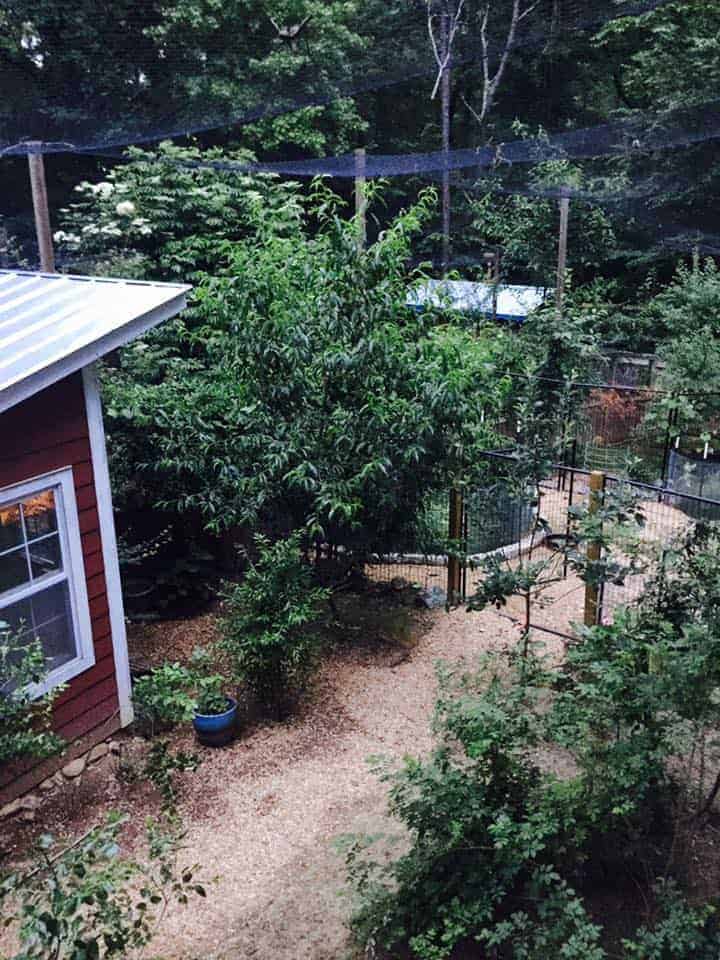
The more interesting and varied the outdoor space, the better. Though many people picture chickens living in open pastures, they are descendants of red junglefowl who, as their name suggests, live in the jungle. Keep this in mind when designing the outdoor space. Ideally the outdoor space will provide both sunny and shady areas, as well as areas with tall vegetation to hide in and explore, and dirt areas to scratch in. Familiarize yourself with plants that are toxic to chickens, and be sure to remove them from your pasture. Read more about plants that are toxic to chickens here. Get creative with the space and add chicken-friendly plants that will add to a jungle-like environment. Certain varieties of bamboo, roses, evergreens, herbs, and fruit trees can be great additions to the space as can the addition of logs, boulders, and other climbing structures.
Chickens need a place to dust bathe, as this is a natural behavior and one that helps keep them healthy by helping to prevent external parasites. Their outdoor space may naturally provide spaces to dust bathe, but during periods of rain or snow, you may need to provide a dust bath. This can be something you build, or you can buy a large litter box, shallow sandbox, kiddie pool, or something similar- just be sure it’s something your chicken residents can safely get in and out of. It is helpful to use something that can be covered to keep the contents dry. Depending on your soil type, you can fill the dust box with dirt from your yard or store bought top soil. The contents should be loose- if your soil is more clay-like or overly hard, it may be best to purchase top soil. Never fill dust boxes with anything that contains fertilizer.
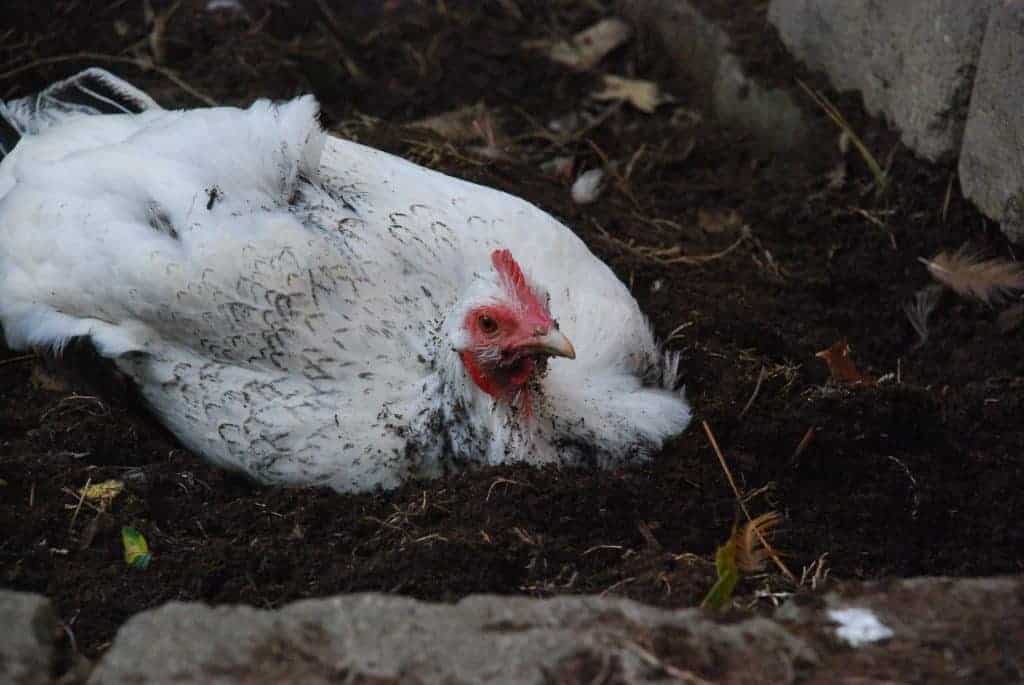
Be sure to create spaces that provide your chicken residents with ample opportunities to exhibit their natural behaviors while still taking the necessary precautions to keep them safe from predators. Not only will this have a positive impact on their overall quality of life, it can also help promote healthy flock dynamics!
Article Acknowledgements
This resource could not have been created without the pioneering work and shared knowledge of compassionate chicken advocates including Farm Sanctuary and Triangle Chicken Advocates.
Interested In Learning More About Chicken Housing And More?
If this resource inspires you to learn more about chicken care, check out our free Basic Chicken Care courses here! Basic Chicken Care Part 1 (both full length versions, large breed-focused and non-large breed-focused) covers housing considerations in much more detail, in addition to feeding, safe cohabitation, and enrichment!
SOURCES
Recommendations For Municipal Regulations Of Urban Chickens | Chicken Run Rescue
Non–Cornish Chicken Care | Farm Sanctuary*
Large Breed Chicken Care | Farm Sanctuary *
Providing A Good Home For Chickens | United Poultry Concerns
Identifying 14 Common Chicken Predators | Morning Chores (Non-Compassionate Source)
Chicken Predators: Your Chicken’s Worst Nightmare (Non-Compassionate Source)
Make A Dust Box For Chickens In Just 5 Minutes | Pampered Chicken Mama (Non-Compassionate Source)
*As of the publishing of this resource, the online care guide does not reflect the updated information provided to 2018 FACC attendees.
If a source includes the (Non-Compassionate Source) tag, it means that we do not endorse that particular source’s views about animals, even if some of their insights are valuable from a care perspective. See a more detailed explanation here.








